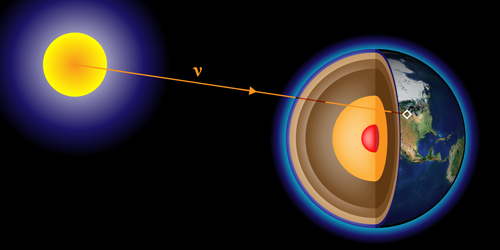Scanning Earth’s Interior with Neutrinos
The Sun showers Earth with neutrinos, but this “glow” doesn’t dim when the Sun goes down. At night, solar neutrinos penetrate Earth, impinging detectors from below. Like x rays in a medical scanner, these planet-traversing neutrinos might offer information about the material they pass through. New theoretical calculations show that future experiments, such as the Deep Underground Neutrino Experiment (DUNE), could characterize the different layers inside Earth with neutrino-based tomography.
The first solar neutrino experiments—starting in the 1960s—discovered a detection rate deficit that was later attributed to neutrinos converting from one flavor to another. These studies also found evidence for a day-night asymmetry, in which the high-energy neutrino rate was a few percent higher during the night than the day. The explanation is that nighttime neutrinos interact with matter as they pass through Earth, and this causes some of them to convert into electron neutrinos, which is the flavor that detectors are most sensitive to.
The neutrino-matter interactions depend on the material’s density, so certain trajectories through Earth should produce a greater nighttime excess than other trajectories. Ara Ioannisian, of the Yerevan Physics Institute in Armenia, and colleagues have calculated the high-energy neutrino rate using an eight-layer Earth model in which the density increases abruptly at each layer boundary. These density “jumps”—particularly those near the surface—have a significant effect on the nighttime signal. The researchers show, for example, that the nighttime excess should decrease slightly whenever the Sun is located 10 degrees below the horizon (that is, post-sunset and pre-dawn). This dip signal, which would offer confirmation of the layer model, could be detected by the DUNE project, which plans to install a 40-kiloton detector in South Dakota by 2027.
This research is published in Physical Review D.
–Michael Schirber
Michael Schirber is a Corresponding Editor for Physics based in Lyon, France.





